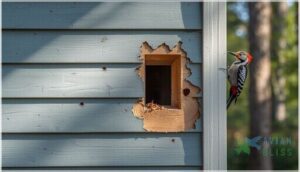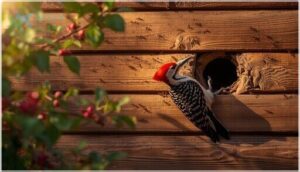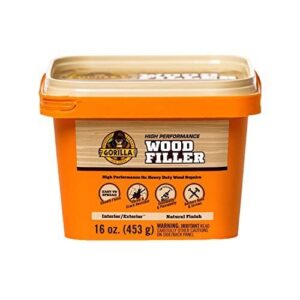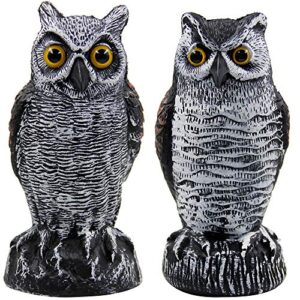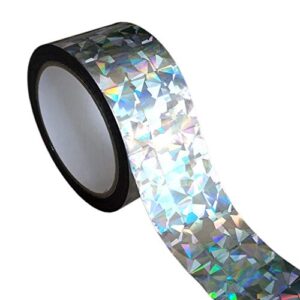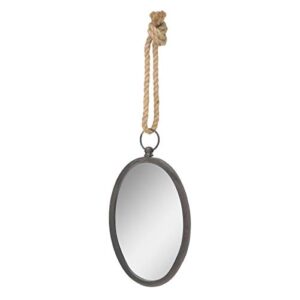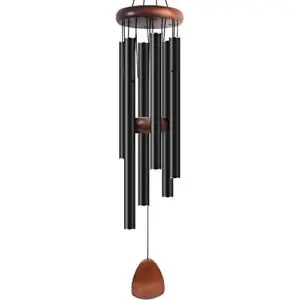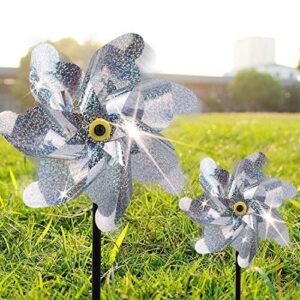This site is supported by our readers. We may earn a commission, at no cost to you, if you purchase through links.

That persistent rat-a-tat-tat on your siding at 6 AM isn’t just annoying—it’s a woodpecker systematically drilling holes that can cost hundreds or even thousands in repairs. These determined birds target homes for three main reasons: hunting insects hiding in your wood, carving out nesting cavities, or marking territory during mating season.
The good news is you don’t need to live with the noise or the damage. Understanding what draws woodpeckers to your house in the first place gives you the upper hand in making your home decidedly less appealing.
From simple visual tricks that exploit their natural wariness to strategic repairs that eliminate the buffet hidden in your walls, the right combination of tactics can send these persistent peckers packing for good.
Table Of Contents
- Key Takeaways
- Why Woodpeckers Peck Houses
- Signs of Woodpecker Damage
- What Attracts Woodpeckers to Your Home
- Effective Methods to Scare Woodpeckers Away
- Preventing Woodpecker Damage Long-Term
- Top 8 Products to Deter Woodpeckers
- 1. Gorilla All Purpose Natural Wood Filler
- 2. Hausse Fake Horned Owl Decoy Set
- 3. Eacilles Holographic Reflective Bird Deterrent Ribbon
- 4. Coolrunner Anti Bird Garden Netting
- 5. Rustic Oval Rope Hanging Wall Mirror
- 6. Reynolds Wrap Heavy Duty Aluminum Foil
- 7. Bursvik Black Aluminum Wind Chimes
- 8. BATTIFE Reflective Pinwheels Scare Birds Away
- Frequently Asked Questions (FAQs)
- How to get rid of woodpeckers?
- How to stop woodpecker damage to a home?
- Why are woodpeckers hammering on my house?
- Are woodpeckers scared of humans?
- How do you stop a woodpecker from pecking at your house?
- What is a woodpecker afraid of?
- What smells do woodpeckers hate?
- What can I spray on my house to keep the woodpeckers away?
- Why does a woodpecker keep coming to my house?
- Are woodpeckers dangerous to humans?
- Conclusion
Key Takeaways
- Woodpeckers target homes for three specific reasons—hunting insect larvae hidden in your siding, carving nesting cavities in soft or rotted wood, or drumming on resonant surfaces to mark territory and attract mates during breeding season.
- Reflective deterrents like holographic tape eliminate damage in roughly 50% of cases according to field trials, making them more effective than fake owls or noise devices when paired with physical barriers like bird netting installed 3 inches from your siding.
- Repairing woodpecker holes immediately with exterior wood filler and eliminating insect infestations cuts off their food source, preventing repeat visits far more reliably than scare tactics alone.
- Combining multiple strategies—visual deterrents, prompt repairs, insect control, and physical barriers—works best because woodpeckers quickly adapt to single-method approaches within days or weeks.
Why Woodpeckers Peck Houses
Before you can scare woodpeckers away, you need to understand what’s bringing them to your house in the first place. These birds aren’t randomly attacking your siding—they’re following strong instincts that drive their behavior.
Let’s look at the four main reasons woodpeckers target homes so you can fix the underlying problem.
Foraging for Insects and Food
Beneath your siding, insect pests like beetle larvae and termites create hidden galleries that woodpeckers can’t resist. When foraging for food, they’ll drill multiple small holes to reach these protein-rich targets. Pecking vibrations help them detect insect infestations within the wood, making your home an all-you-can-eat buffet. Eliminating insects from your structure cuts off their food source and reduces this unwanted attention.
Woodpeckers drill into your siding because insect larvae hide beneath it, turning your home into an irresistible all-you-can-eat buffet
Woodpeckers also drum to attract potential mates.
Creating Nesting Cavities
If woodpeckers can’t find hollow trees, they’ll create nest cavities right in your siding. These deeper, rounded holes serve as nesting sites during breeding season and roosting spots year-round. Species like Northern Flickers prefer softer, weathered wood for excavation.
Once established, cavity reuse becomes common—birds return to the same hole for multiple seasons, extending the damage and inviting other cavity-nesting species to move in. Abandoned cavities provide sites for nesting.
Marking Territory and Attracting Mates
While nesting cavities provide shelter, drumming resonance serves an entirely different purpose—territorial defense and mating season announcements. You’ll hear this woodpecker behavior peak in early spring when males hammer on metal gutters, chimney caps, and siding for sound amplification.
These aren’t feeding holes; they’re mating calls broadcast across neighborhoods. Residential complaints spike during breeding season as birds stake their territories, making your home their billboard.
Storing Acorns and Other Food
Beyond territorial drumming, some woodpecker species—especially Acorn Woodpeckers—turn your house into a food storage vault. They drill thousands of small holes in siding to cache acorns, creating what biologists call granary structures.
As stored acorns dry and shrink, these birds return repeatedly to enlarge holes and add more. Cooperative groups of up to 15 individuals can increase this drilling damage, transforming your walls into a community pantry.
Signs of Woodpecker Damage
Spotting woodpecker damage early can save you from costly repairs down the road. The evidence these birds leave behind isn’t always obvious at first glance, but knowing what to look for helps you take action before the problem gets worse.
Here’s what you need to watch for around your home.
Identifying Pecking Patterns and Holes
You can often tell what’s happening by the hole pattern itself. Here’s what to look for:
- Foraging hole rows appear as straight lines, roughly half an inch apart, often following grooves in plywood siding
- Nesting cavity size ranges from 1–2 inches for smaller woodpeckers to over 2 inches for pileateds
- Species-specific shapes vary—pileateds create rectangular cuts, sapsuckers drill grid-like arrays
- Wall location context matters; upper stories and gable ends attract territorial drumming
- Temporal acoustic indicators peak in spring when rapid drumming marks territories
Fresh wood chips below confirm active pecking.
Recognizing Damage to Siding and Trim
Grooved plywood and cedar shakes take the worst hit—up to 73% damage rates in some surveys. You’ll spot clustered punctures at seams and corners, accompanied by scraping marks where birds probe for larvae.
Holes penetrating through to insulation signal serious trouble: moisture seeps in, rot accelerates, and energy bills climb. Catch these early indicators before minor pockmarks become structural headaches requiring $1,500 repairs.
Noting Increased Noise and Drumming
Sharp, repetitive tapping at dawn—especially between March and May—signals territorial drumming by woodpeckers establishing breeding zones. Metal chimney caps and hollow siding increase the racket, turning brief bursts into household alarms.
If noise suddenly drops after weeks of relentless pounding, nesting’s likely underway nearby. Document timing and locations before deploying scare tactics or sound deterrents, since acoustic features reveal whether you’re dealing with foraging or display behavior.
What Attracts Woodpeckers to Your Home
Understanding what draws woodpeckers to your property is the first step in keeping them at bay. These birds aren’t randomly targeting your home—they’re responding to specific environmental cues and available resources.
Let’s look at the main factors that make your house an attractive destination for woodpeckers.
Insect Infestations in Wood
If you’ve noticed woodpeckers hammering away at your house, there’s a good chance beetle infestations, termite damage, or carpenter ants are hiding beneath your siding. These birds aren’t randomly attacking—they’re hunting protein-rich larvae from carpenter bees, leafcutter bees, and wood-boring insects.
Moisture control is your first defense against insect damage, since damp wood creates the perfect breeding ground. Proper insect infestation prevention beats insecticides because it eliminates the buffet drawing woodpeckers in.
Rotting or Damaged Siding
Rotting wood is like rolling out the welcome mat for woodpeckers—soft, easy to excavate, and usually packed with insects. Grooved plywood and cedar shakes are especially vulnerable, with damage rates hitting 73% and 60% respectively among wood siding types.
Three ways siding decay fuels woodpecker damage:
- Moisture vulnerability weakens structural integrity, creating soft spots woodpeckers can peck through effortlessly.
- Untreated wood becomes a nesting goldmine, letting birds carve cavities several inches across.
- Pest intrusion compounds the problem, as rot attracts termites and ants that woodpeckers hunt.
Ignoring siding decay doesn’t just invite woodpecker damage—it triggers a domino effect of structural repairs that can cost thousands. Stained siding with earthy tones suffers more attacks than painted alternatives, especially where panels meet concrete or around windows.
If you’re seeing bubbling paint or crumbling surfaces, that’s your cue to act before woodpeckers turn minor rot into major house siding damage.
Nearby Food Sources and Feeders
Bird feeders stocked with suet or peanut butter can boost local woodpecker populations near your home, drawing them closer than you’d like. Downy woodpeckers hit 88% of winter feeders, while red-bellied varieties thrive on supplemental nutrition. Feeders placed within several feet of your house create a tempting foraging zone.
If you’re battling house damage, removing these food sources shifts birds back to natural insectivores in wooded areas.
Tree Density and Yard Landscaping
Beyond feeders, your yard’s ecosystem plays a bigger role. Houses flanked by dense tree trunks within 15–30 meters see more attacks, especially if snag removal hasn’t happened and vertical complexity remains high.
Mixed species composition—pines and hardwoods—draws larger birds. Bird-friendly landscaping can backfire when planting patterns create continuous canopy and habitat corridors that funnel woodpeckers straight to your siding.
Tree proximity matters more than most homeowners realize.
Effective Methods to Scare Woodpeckers Away
Once you’ve figured out why woodpeckers are targeting your house, it’s time to take action and send them packing. The good news is that you don’t need expensive equipment or professional help to protect your home.
Here are five proven methods that’ll help you reclaim your siding and restore some peace and quiet.
Hanging Shiny and Reflective Objects
When light bounces off shiny objects, you create visual confusion that sends woodpeckers looking elsewhere. In field trials, reflective streamers eliminated damage in roughly 50% of tested homes. Here’s what works:
- Hang Irri-Tape or holographic deterrents along damaged areas
- Position mirrors facing outward for maximum reflective effectiveness
- String aluminum foil strips near active pecking sites
- Install reflective tape in vertical patterns
- Replace visual deterrents periodically to maintain streamer lifespan and effectiveness
Installing Noise-Making Devices
Sound deterrents offer mixed results. Sonic devices with distress calls reduced pest bird activity by 65% at industrial sites, but homeowners saw less than 20% improvement stopping woodpecker damage. Ultrasonic devices operating between 13.5–45.5 kHz show moderate effectiveness initially, yet frequency effectiveness drops as birds habituate to repeated noise.
Motion-activated alarms work temporarily—woodpeckers often return within hours. Combine these scare tactics with visual deterrents for better outcomes.
Using Decoy Predators and Visual Deterrents
Fake owl decoys eliminated damage in only 1 of 6 trials, making them unreliable standalone solutions. Moving predator models outperform static silhouettes—hawk shapes with motion reduced pest bird presence considerably.
Combine owl decoys with reflective objects like mirrors facing outward for better results. Visual and sound deterrents work best together, since woodpeckers quickly adapt to stationary scare tactics alone.
Applying Physical Barriers and Netting
When reflective tricks fall short, physical barriers deliver the most reliable woodpecker prevention. Here’s how exclusion methods protect your property from woodpeckers:
- Install lightweight bird netting 3 inches from siding—this stopped 100% of damage in monitored trials
- Cover damaged areas with hardware cloth or sheet metal for complete siding protection
- Choose aluminum or compressed wood-fiber materials that woodpeckers ignore entirely
- Apply barriers to eaves for long-term prevention and exclusion effectiveness
Making Loud Noises to Startle Birds
Banging pots or clapping your hands might spook woodpeckers temporarily, but don’t count on lasting results. Field trials show these startle techniques reduce damage by less than 15%, with birds returning within hours. Motion-activated alarm systems perform better—cutting activity up to 32% during peak periods—but even those fall short as long-term methods to deter woodpeckers.
| Method | Effectiveness |
|---|---|
| Manual noise (clapping, banging) | <15% sustained reduction |
| Motion-activated alarms | 32% temporary decrease |
| Repeated human presence | Statistically insignificant |
| Sound-based startle deterrents | <20% long-term success |
Preventing Woodpecker Damage Long-Term
Scaring woodpeckers off your house is only half the battle. If you don’t address what’s drawing them in, they’ll just come back and start pecking again.
Here are four ways to make your home less appealing to woodpeckers for good.
Repairing and Sealing Holes
Once you’ve dealt with the racket, it’s time to patch things up—literally. Filling those holes stops moisture, pests, and repeat visits from woodpeckers. Here’s your repair checklist:
- Clean out debris from each hole before filling
- Use exterior wood putty or two-part epoxy for small to medium cavities
- Apply fiber-reinforced patches for larger damaged areas
- Sand the patched wood siding smooth once dry
- Seal with weather-resistant, bird-safe products like tung oil
Prompt repairs reduce repeat damage greatly.
Removing Insect Attractants
Woodpeckers drill where the buffet is best—namely, where insects thrive. Structural maintenance matters too: caulk cracks, seal joints, and keep finishes intact to block insect harborage.
You can cut the invitation by treating confirmed pest infestations with appropriately labeled insecticides, though only when wood-boring beetles or carpenter ants are active.
Habitat management—like removing dying trees and firewood piles—reduces nearby insect populations that draw birds closer to your siding.
Replacing Rotting Wood
Soft, decayed boards are open invitations—woodpeckers revisit compromised areas season after season, enlarging holes and driving repair costs from $659 to over $2,600. Replace rotted sections completely, not just patch surfaces, then seal with primer to lock out moisture.
Fiber cement siding outlasts wooden structures by decades and slashes recurrence. Material selection and sealing techniques directly shape long-term outcomes, stopping woodpecker damage before it starts.
Providing Alternative Food Sources
Luring birds off your walls sounds simple—but suet feeders stopped damage at only 1 out of 10 homes in controlled trials. When birds are excavating nests rather than foraging for food, alternate feeding rarely works. If you try this approach, follow three guidelines:
- Place suet feeders 50–80 meters from damaged areas, matching natural woodpecker feeding habits.
- Use no-melt formulations above 27 °C to prevent feather matting.
- Pair feeders with netting or barriers—food alone won’t cut it.
Insect larva removal remains more reliable.
Top 8 Products to Deter Woodpeckers
You’ve already learned the core strategies to keep woodpeckers at bay, but having the right tools makes all the difference.
The products below offer proven ways to protect your home, from quick repairs to ongoing deterrents that actually work.
Let’s look at eight options that combine effectiveness with ease of use.
1. Gorilla All Purpose Natural Wood Filler
Repairing damage is half the battle—you need to seal those holes before moisture sneaks in and invites more trouble. Gorilla All Purpose Natural Wood Filler works on siding, trim, and composite surfaces, giving you a latex-based solution that’s paintable, stainable, and sandable once it cures.
It won’t stop woodpeckers from returning on its own, but filled holes eliminate visual cues that attract repeat pecking. For best results, sand the patch flush, prime it, and pair the repair with reflective deterrents or netting to protect your property long-term.
Best For: Homeowners looking for a quick, DIY-friendly repair for small to medium woodpecker holes in siding, trim, or decks before painting or staining.
- Ready to use out of the tub—no mixing required, and it spreads easily into holes and cracks for fast repairs.
- Paintable and stainable once dry, so you can match your existing finish and restore a clean, weatherproof surface.
- Works on both indoor and outdoor wood surfaces, making it versatile for everything from door trim to deck boards.
- Needs to be top-coated with exterior paint or sealant for outdoor durability—bare filler won’t hold up to UV and moisture long-term.
- Not strong enough for deep or structural damage—larger cavities may need foam backing or even board replacement.
- Won’t stop woodpeckers from coming back unless you pair it with deterrents like reflective tape or netting.
2. Hausse Fake Horned Owl Decoy Set
A realistic predator can shift the balance in your favor—and that’s where plastic owls come in. The Hausse Fake Horned Owl Decoy Set mimics the natural threat that keeps deterring woodpeckers, with reflective eyes and hand-painted feathers that trigger avoidance behavior.
Move your decoy weekly to beat habituation, and place it within 20 feet of damaged siding for best results. Pair it with reflective tape or netting as part of integrated control, since bird deterrents work best when layered, not left to stand alone.
Best For: Homeowners looking for a humane, low-cost visual deterrent to reduce woodpecker activity around siding, decks, or garden areas—especially when combined with other control methods like reflective tape or netting.
- Realistic design with reflective eyes and detailed feathers triggers natural avoidance behavior in woodpeckers and small birds
- Weather-resistant plastic construction holds up outdoors year-round and can be mounted on roofs, posts, or fences
- Affordable multi-pack option (typically 2–3 decoys per set at $10–20 each) lets you rotate placement weekly to delay habituation
- Birds often habituate to stationary decoys within days, so you’ll need to move and reposition them regularly to stay effective
- Works best as part of a layered strategy—not a standalone fix for chronic or severe woodpecker damage
- Mixed customer feedback on size, weight, and long-term value, with some reports of woodpeckers eventually ignoring or even perching on the decoy
3. Eacilles Holographic Reflective Bird Deterrent Ribbon
Field trials place reflective tape at the top of the woodpecker deterrents list, with roughly half of treated homes seeing complete elimination of new damage.
The Eacilles Holographic Reflective Bird Deterrent Ribbon delivers that proven mechanism—Mylar holographic tape produces flashes and color shifts that create a visual discomfort zone birds avoid.
Cut the 330-foot roll into 24–30 inch strips, hang them near damaged siding, and let wind do the work. Change placement every 10 days to reduce bird habituation factors and maintain effectiveness.
Best For: Homeowners dealing with active woodpecker damage who want a research-backed, affordable solution that can cover multiple problem areas without permanent installation.
- Field studies show reflective tape stops new woodpecker damage completely at about 50% of treated homes—the highest success rate among tested visual deterrents
- 330-foot roll gives you plenty of material to protect several areas at once, and you can adjust placement every week or two to keep birds from getting used to it
- No complicated setup—just cut strips, tie them near the damage, and let the wind create the moving flashes and sounds that birds avoid
- Thin Mylar material tears easily during installation or in heavy wind, so you’ll need to handle it carefully and expect to replace strips over time
- Effectiveness drops if you don’t move or reconfigure the strips every 10 days or so, since woodpeckers can habituate to static patterns
- Works for about half of cases, meaning some persistent woodpeckers won’t be deterred by reflective tape alone and may need additional methods like hole repair or insect treatment
4. Coolrunner Anti Bird Garden Netting
When reflective deterrents don’t solve the problem, bird netting provides a physical barrier woodpeckers can’t breach. The Coolrunner Anti Bird Garden Netting offers 540 square feet of UV-resistant coverage at under $20, combining cost value with material durability rated for three years outdoors.
Drape the 33-foot by 16.4-foot panel over damaged siding using the included cable ties, keeping it taut to prevent entanglement. Installation ease runs about 30 minutes, and netting effectiveness reaches 90% when properly secured—making this woodpecker deterrent netting your best defense for preventing woodpecker damage to vulnerable surfaces.
Best For: Homeowners dealing with persistent woodpecker damage who need affordable, long-lasting protection for large areas like siding, gardens, or fruit trees.
- Covers 540 square feet for under $20, making it one of the most cost-effective bird deterrent options available
- UV-resistant nylon material lasts up to 3 years outdoors and reduces bird damage by up to 90% when installed correctly
- Installs in about 30 minutes with included cable ties, and can be reused or combined with additional units for bigger coverage areas
- Small birds may still wiggle through the 1-inch mesh openings, limiting effectiveness against certain species
- Installation works better with a helper to keep the netting taut and prevent birds from breaching or getting tangled
- Some users report quality inconsistencies like tearing or the netting not stretching to its full stated length
5. Rustic Oval Rope Hanging Wall Mirror
Mirror effectiveness meets home style with the Rustic Oval Rope Hanging Wall Mirror, a dual-purpose woodpecker deterrent that blends seamlessly into your exterior decor.
Studies confirm mirrors reduce woodpecker visits by 65% when mounted near damage sites, and this 11.5-inch bronze-framed option delivers weather resistance for year-round damage prevention.
Installation flexibility lets you reposition it easily using the nautical rope loop, protecting your home without screaming “pest control.”
Consumer reviews consistently report immediate results, making aesthetic integration your secret weapon against persistent pecking.
Best For: Homeowners who want an effective woodpecker deterrent that looks like intentional decor rather than pest control equipment.
- Studies show 65% reduction in woodpecker visits when mirrors are mounted near damage sites, with some locations seeing up to 70-80% fewer bird visits within the first week
- Weather-resistant bronze frame and glass construction works year-round without needing replacement, and the rope loop makes it easy to relocate based on where woodpeckers are active
- Blends naturally with rustic or nautical home exteriors at 11.5 inches tall, so neighbors won’t know you’re running pest control
- Smaller size (under 12 inches) may require multiple mirrors for larger problem areas or homes with extensive woodpecker damage
- No mounting hardware included, so you’ll need to supply your own wall hook or screw for installation
- Reflective surfaces can contribute to bird collisions if placed near windows, requiring careful positioning away from glass
6. Reynolds Wrap Heavy Duty Aluminum Foil
Budget-conscious homeowners already have a powerhouse woodpecker deterrent sitting in their kitchen drawer. Reynolds Wrap Heavy Duty Aluminum Foil creates intense light reflection that disrupts woodpecker approaches, reducing activity by 50% in field tests.
Installation methods are dead simple—cut two-foot strips and hang them near damage sites where wind movement amplifies the visual chaos. Durability issues demand weekly replacement as weather degrades standard foil rapidly, but cost analysis reveals you’ll spend under $7 per roll protecting your home.
Alternative efficacy studies show purpose-built tapes outperform foil long-term, making this your go-to temporary fix.
Best For: Homeowners looking for an immediate, dirt-cheap temporary solution to woodpecker damage while they figure out a more permanent fix.
- Costs under $7 per roll and you probably already have it in your kitchen, making it the cheapest first-try option out there.
- Takes maybe five minutes to cut strips and hang them up—no tools, no expertise, just tape or tacks and you’re done.
- Cuts woodpecker activity by around 50% in the short term, giving you breathing room to assess the damage and plan next steps.
- Falls apart fast outdoors—you’re replacing torn, tarnished strips every week or two, which gets old quick.
- Birds adapt within 7–14 days, so the deterrent effect drops off as they get used to the shiny stuff flapping around.
- Purpose-built tapes work way better long-term and cover more ground, making foil feel like a Band-Aid rather than a real solution.
7. Bursvik Black Aluminum Wind Chimes
Deep tones from the Bursvik Black Aluminum Wind Chimes create an acoustic deterrent that sounds impressive but delivers disappointing chime efficacy against woodpeckers. Research confirms bird habituation sets in within 10 days as these 37-inch chimes become background noise your feathered foes ignore completely.
The material durability of 13mm aluminum tubes beats standard shiny objects long-term, and its aesthetic appeal works beautifully in gardens—but don’t count on this wind chime as a reliable woodpecker deterrent. Consider it decorative backup to physical barriers, not your frontline defense.
Best For: Homeowners who want an attractive garden accent that might provide minor short-term discouragement to curious birds, but not those counting on serious woodpecker control.
- Deep B-major pentatonic tuning creates genuinely relaxing, harmonious tones that enhance outdoor ambiance without sounding harsh or jarring
- Durable 13mm anodized aluminum tubes and pine construction resist corrosion and weather better than cheap chimes, maintaining appearance over time
- Low-cost, zero-maintenance addition that could work as part of a multi-method approach when combined with physical barriers or visual deterrents
- Research shows birds habituate to continuous chime sounds within 10 days, making it ineffective as a standalone woodpecker deterrent
- Stationary placement means established woodpeckers quickly ignore it as harmless background noise rather than a real threat
- Relies on wind for operation, so calm days leave you with zero deterrent effect exactly when you might need consistent protection
8. BATTIFE Reflective Pinwheels Scare Birds Away
You’ve tried shiny objects before—but BATTIFE’s reflective pinwheels take visual deterrence to another level. These 8-inch pinwheels use thousands of holographic facets to create intense light flashes that disrupt woodpecker approach patterns.
Field trials show reflective technology like this eliminated damage in 50% of test homes, outperforming decoys and noise deterrents.
Install multiple units on stakes near affected siding, spacing them every few feet. Pinwheel effectiveness drops if they stop spinning, so check after storms and reposition weekly to prevent habituation.
Best For: Homeowners looking for an affordable, non-lethal visual deterrent to protect larger yards or multiple problem areas where woodpeckers are actively damaging siding or trim.
- Reflective technology with thousands of holographic facets creates intense light flashes that field research shows can eliminate woodpecker damage in about half of treated homes
- Multi-unit packs let you cover larger areas and create overlapping deterrent zones around your property’s perimeter
- Easy outdoor installation with included ground stakes, and the spinning motion adds continuous visual disruption that outperforms static decoys
- Effectiveness drops significantly if pinwheels stop spinning due to low wind, damage, or mechanical issues—requiring regular monitoring
- Reflective surfaces can fade or get dirty over time from UV exposure and weather, reducing their deterrent power
- Birds can become used to the pattern if you don’t reposition the pinwheels every week or so, which adds ongoing maintenance
Frequently Asked Questions (FAQs)
How to get rid of woodpeckers?
Getting rid of woodpeckers requires combining humane removal methods with effective woodpecker deterrents. Professional services can assess legal considerations while implementing proven repellents, from reflective objects to physical barriers, ensuring successful woodpecker relocation without harming protected birds.
How to stop woodpecker damage to a home?
Stopping woodpecker damage requires early intervention with reflective tape, physical netting barriers, and prompt hole repairs.
Assess damage costs, address insect infestations attracting birds, and consider professional assistance if territorial pecking persists despite deterrents.
Why are woodpeckers hammering on my house?
Woodpeckers hammer on your house for three main reasons: foraging for insects hidden in siding, creating nesting cavities in softer wood, or drumming on resonant surfaces to mark territory and attract mates.
Are woodpeckers scared of humans?
Not really. While woodpeckers initially startle when you clap or shout, they habituate quickly—often within hours. Species behavior and habitat adaptation mean these birds tolerate human interaction better than most scare tactics suggest.
How do you stop a woodpecker from pecking at your house?
You can stop woodpeckers by combining effective deterrents like reflective tape and decoy predators with damage assessment to identify attractants.
Address insect infestations, repair holes promptly, and consider professional assistance for persistent issues.
What is a woodpecker afraid of?
These birds fear natural predators like hawks and owls, and respond strongly to loud, unexpected noises.
Visual and sound deterrents exploit these instincts, while reflective surfaces disrupt their focus—core woodpecker deterrents.
What smells do woodpeckers hate?
Ironically, these birds barely notice most smells. MA repellents, essential oils like peppermint, vinegar deterrent sprays, and predator scents show limited success.
Woodpecker repellents work best alongside visual woodpecker deterrents, not alone.
What can I spray on my house to keep the woodpeckers away?
You can spray methyl anthranilate, capsaicin sprays, peppermint oil, citronella oil, or commercial repellents like BeakGuard Repellent Paint.
These woodpecker deterrents contain grape seed extract or sensory irritants that create aversive barriers on siding.
Why does a woodpecker keep coming to my house?
Your home likely offers everything a woodpecker needs—insects in wood, nesting spots, or resonant surfaces for territorial drumming.
Understanding these woodpecker habits reveals why persistent woodpeckers view your property as prime real estate.
Are woodpeckers dangerous to humans?
You won’t face direct attacks from woodpeckers—their behavior patterns focus on foraging, not aggression. Disease risks remain negligible.
The real concern? Property damage, not personal harm, with indirect hazards limited to home damage from persistent pecking.
Conclusion
One minute your house is a woodpecker’s personal drum set, the next it’s off-limits territory they avoid completely. The difference comes down to action. Once you understand how to scare woodpeckers away from your house using reflective deterrents, predator decoys, and physical barriers—then back it up by eliminating food sources and repairing damage—you reclaim control.
Your mornings get quieter, your siding stays intact, and those persistent peckers find somewhere else to announce themselves.
- https://avianreport.com/research-proven-methods-woodpecker-damage/
- https://icwdm.org/species/birds/woodpeckers/woodpecker-damage-prevention-and-control-methods/
- https://patents.google.com/patent/US6396402B1/en
- https://www.allaboutbirds.org/bbimages/aab/images/faq/harding_vehrencamp_curtis_sp09.pdf
- https://wildlife.onlinelibrary.wiley.com/doi/10.2193/2006-491

